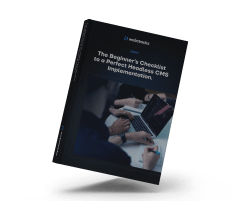In the fast-paced business-to-business (B2B) market, digital accessibility might not always take center stage. However, in an era where inclusivity and diversity are increasingly essential for success, can you afford to overlook the importance of making your B2B website accessible and usable for everyone?
This article explores why B2B companies should prioritize digital accessibility, its benefits, and how it aligns with broader business goals.
Key Takeaways
- Digital accessibility is crucial for B2B companies to reach and serve a diverse customer base.
- Accessibility aligns with legal requirements and ethical obligations to provide inclusive digital experiences.
- Prioritizing accessibility can expand your market reach, improve SEO, and enhance the overall user experience.
- Implementing accessibility best practices from the start of your website design process is key.

What is B2B Website Accessibility
B2B website accessibility means designing and developing websites that everyone can use, including people with disabilities. It involves creating digital platforms that are inclusive, ensuring all users, regardless of their abilities, can access, understand, and interact with your online content effectively.
Accessibility is vital for providing equal access to your products and services. With 15% of the world's population experiencing some form of disability, an accessible website allows you to connect with more potential clients. It also improves the user experience for everyone by making your site easier to navigate and understand.
The Importance of B2B Website Accessibility
One of the key reasons B2B companies should prioritize digital accessibility is the dynamic legal and ethical climate surrounding it. Many countries have implemented regulations that mandate accessibility for digital platforms, such as the Americans with Disabilities Act (ADA) in the United States and the European Accessibility Act (EAA) in the European Union.
Failing to comply with these accessibility laws and compliance requirements can lead to legal consequences, tarnish a company's reputation, and result in financial penalties. Web accessibility lawsuits are growing, with 414 federal ADA cases filed in the first half of 2023.
Beyond legal requirements, there is a growing awareness that digital accessibility is an ethical obligation. B2B companies that demonstrate a commitment to B2B web accessibility and accessibility compliance are more likely to be viewed positively by customers, partners, and the broader community, as they are seen as considerate of the needs of individuals with disabilities.
Core Principles of B2B Website Accessibility
Creating an accessible B2B website is essential for reaching a wider audience and ensuring an inclusive user experience. Focusing on key guidelines helps you make your site more accessible to all users.
Comply with Legal Accessibility Regulations
Ensuring your website meets legal accessibility standards is crucial to avoid potential lawsuits. B2B companies are subject to accessibility laws like the ADA.
- Avoid Legal Risks: 28% of B2B organizations have faced legal action related to digital accessibility in the past year.
- Follow WCAG 2.1 AA Standards: Aim for Level AA compliance to balance practicality and comprehensive accessibility.
How to Stay Compliant:
- Regularly Audit Your Website: Use tools like WAVE or axe to identify and fix accessibility issues.
- Integrate Accessibility into Processes: Consider accessibility from the beginning of your design and development stages.
- Consult Accessibility Experts: Engage professionals who specialize in web accessibility to ensure compliance.
By prioritizing legal compliance, you protect your business from legal risks and demonstrate a commitment to inclusivity.
Maintain Proper Color Contrast and Text Readability
Proper color contrast and text readability are essential for users with visual impairments. Ensuring that your website's text is easy to read helps all users navigate your site more effectively.
Best Practices:
- Use High-Contrast Color Schemes: Aim for a contrast ratio of at least 4.5:1 for normal text and 3:1 for large text.
- Avoid Relying Solely on Color: Don’t use color as the only means of conveying information or indicating actions.
- Choose Readable Fonts: Use sans-serif fonts and maintain sufficient font sizes (minimum 16-18pt or 14pt bold).
- Limit Line Lengths: Keep line lengths to 70 characters or fewer to enhance readability.
Tools like Adobe's Color Contrast Analyzer can help you check compliance with contrast standards.
Provide Text Alternatives for Images and Multimedia
Providing text alternatives ensures that users who rely on assistive technologies can understand your content.
- Descriptive Alt Text: Include detailed descriptions for images, not just "image of a chart" but "Line chart showing a 20% increase in sales over Q2."
- Captions and Transcripts: Provide captions for videos and transcripts for audio content.
This practice enhances accessibility and can improve SEO by providing more content for search engines to index.
Create Accessible Forms and Interactive Elements
To make forms and interactive elements accessible:
- Label Form Fields Clearly: Help users understand what information is required.
- Provide Error Messages in Text: Enable users to correct mistakes easily.
- Ensure Keyboard Accessibility: Users should navigate forms using a keyboard, tabbing through fields logically.
- Logical Grouping and Instructions: Design forms with logical grouping and clear instructions to enhance usability.
Ensure Compatibility with Assistive Technologies
Making your website compatible with assistive technologies enhances accessibility for users with disabilities.
- Test with Screen Readers: Use screen readers like NVDA or JAWS to identify and fix issues.
- Use Semantic HTML: Structure your HTML with proper semantic elements so content is read in the correct order.
- Implement ARIA Roles: Use Accessible Rich Internet Applications (ARIA) to improve the accessibility of non-semantic HTML elements.
Key Qualities of Accessible Design for B2B Websites
Designing and developing B2B websites with accessibility in mind is crucial for ensuring that all users, including those with disabilities, can effectively interact with and navigate your online presence.
The key principles of accessible design, as outlined in the Web Content Accessibility Guidelines (WCAG), are the foundation for creating inclusive B2B websites.
Perceivable: Ensuring Content is Visible and Understandable
The “perceivable” principle focuses on making content available and understandable to users, regardless of their sensory capabilities.
This includes providing text alternatives for non-text content, such as images and videos, and ensuring that the color contrast between text and background is sufficient for users with visual impairments.
Though black and white is considered the most accessible combination, a red, yellow, and blue palette is best for those with color blindness, which affects 300 million people worldwide.
Operable: Making All Functionality Available via Keyboard and Other Inputs
The “operable” principle ensures that all website functionality can be accessed and operated through many input methods, including the keyboard.
This accommodates users with physical disabilities who may have difficulty using a mouse or touchscreen. By making navigation and interactive elements keyboard-friendly, you can create a more inclusive experience.
Understandable: Creating Predictable and Intuitive Navigation
The "understandable" principle focuses on making your B2B website easy to navigate for all users by ensuring that your design is intuitive and consistent. This includes predictable navigation paths, clear labeling, and user-friendly instructions. Here are some best practices and examples:
- Consistent Navigation Structure: Ensure your main navigation menus are consistent across all pages, helping users build familiarity with your site. For example, keep the primary menu in the same position with the same options throughout the site.
- Descriptive Link Text: Instead of vague phrases like "Click Here" or "Learn More," use specific labels like "Download Our Whitepaper" or "View Product Details." This clarity helps users understand where the link will take them.
- Logical Menu Grouping: Organize menu items into clear categories. For example, group related items under headers like “Products,” “Solutions,” or “Resources,” so users can easily locate the information they need.
Robust: Ensuring Compatibility with Assistive Technologies
The "robust" principle ensures that your B2B website remains functional and accessible across various assistive technologies and devices, helping users with disabilities interact with your content effectively.
- Adherence to Web Accessibility Standards: Implement guidelines like WCAG (Web Content Accessibility Guidelines) 2.1, ensuring compatibility with technologies like screen readers. This includes using proper semantic HTML (e.g., headings, lists, and landmarks) to convey structure.
- Keyboard Accessibility: Ensure that all interactive elements, such as menus, forms, and buttons, can be navigated and operated using only a keyboard. For example, users should be able to tab through all links in a logical sequence without getting stuck or skipping content.
- ARIA (Accessible Rich Internet Applications) Attributes: Use ARIA roles, properties, and states to enhance the accessibility of dynamic content. For example, adding aria label to icons ensures that screen readers convey the function of an element that may not have visible text.
By incorporating these key principles of accessible design into your B2B website development and design process, you can create a more inclusive and user-friendly online experience for all your customers and stakeholders.

Best Practices for Enhancing B2B Website Accessibility
A truly accessible B2B website requires meticulous attention to detail across various aspects.
From ensuring readability and contrast in your text and content to providing text alternatives for multimedia elements, each component plays a crucial role in delivering an inclusive user experience.
Text and Content: Readability and Contrast
Prioritize readability by using a minimum font size of 16-18 points (or 14 points in bold) and maintaining a color contrast ratio that meets WCAG (Web Content Accessibility Guidelines) standards.
For best readability, headings should be around 1.96 x larger than your body text to create a sufficient contrast. This combination of font size and contrast ratio helps users with visual impairments easily navigate and comprehend your website's content.
Multimedia: Providing Text Alternatives for Images and Videos
For images, illustrations, and videos, it’s essential to provide descriptive alt text that accurately reflects the visual content and its context.
Alt text should go beyond basic descriptions like "image of a person" and instead convey meaningful details, such as "Image of a person presenting a graph showing year-over-year sales growth." For videos, include captions and transcripts for all spoken content, as well as descriptions for any critical visual information.
This ensures that users who rely on screen readers and have limited vision, or experience hearing impairments can fully access and understand the content presented through multimedia elements.
Navigation: Clear and Consistent Menus and Links
A well-structured navigation system is crucial for all users, especially those with cognitive or motor impairments.
Design your menus and links to be consistent across all pages, with intuitive categories and descriptive labels that indicate where each link will take the user.
For example, instead of vague labels like “Learn More,” use descriptive text like “Explore Our Solutions” or “View Case Studies.” Additionally, ensure the navigation structure is logical and follows a predictable order, making it easier for users to navigate your website without confusion.
Forms: Accessible Labels and Instructions
When creating forms, make sure each field is clearly labeled with descriptive text placed close to the input area. Labels should be programmatically associated with their respective fields, allowing screen readers to correctly interpret the information.
Instructions should be provided for complex form fields or required fields, using simple language and visual cues (such as asterisks for mandatory fields). Include error messages that are easy to understand and offer guidance on how to correct input errors, ensuring that users with cognitive, learning, or visual disabilities can complete the forms with confidence.
Interactive Elements: Focus Management and Accessible Controls
Interactive elements such as buttons, CTAs, and links need to be fully operable through keyboard navigation alone, allowing users with mobility impairments to engage with your site.
Proper focus management is crucial—ensure that focus moves logically through the page and is visually indicated, such as by highlighting the active button or link with a border or background change.
Avoid using complex or custom controls that are not keyboard-accessible, and always provide clear labels or instructions for interactive features like dropdowns, sliders, or modals. Ensuring intuitive and accessible controls improves the overall user experience, particularly for those with limited dexterity or mobility.
Implementing these best practices for text and content, multimedia, navigation, forms, and interactive elements can create a B2B website that is truly accessible and inclusive for all users, regardless of their abilities or assistive technologies.
Tools and Resources for B2B Website Accessibility
Enhancing the accessibility of your B2B website is crucial. Fortunately, various tools and resources are available to help you achieve this goal. These tools help to minimize exclusion for the 49% of working-age adults who feel excluded from society because of their condition or impairment.
From accessibility auditing tools to online courses and tutorials, these solutions can guide you in creating a more inclusive and user-friendly digital experience for all your visitors.
Accessibility Auditing Tools
Platforms like the Bureau of Internet Accessibility offer comprehensive accessibility auditing tools that can identify issues on your B2B website and provide recommendations for improvement.
These tools analyze your site's compliance with the Web Content Accessibility Guidelines (WCAG) and other industry standards, helping you pinpoint areas that need attention.
Browser Extensions for Testing
Browser extensions such as WAVE, Axe, and NoCoffee can be invaluable in testing the accessibility of your B2B website directly within the browser.
These tools allow you to simulate different user conditions, such as vision impairments or keyboard-only navigation, and quickly identify areas that require further optimization.
Online Courses and Tutorials
Enhance your team's knowledge and skills in web design that is accessible by exploring the wealth of online courses and tutorials available.
The W3C Web Accessibility Initiative, for example, offers comprehensive training programs that delve into the principles of WCAG and provide practical guidance on implementing accessible practices.
Guidelines from WCAG and Other Standards Bodies
The Web Content Accessibility Guidelines (WCAG) and other industry standards, such as those from the International Organization for Standardization (ISO), provide comprehensive guidelines and best practices for creating accessible digital experiences.
These resources can serve as a valuable reference point as you work to improve the accessibility of your B2B website.
Implementing Accessibility in Your B2B Website Design Process
Incorporating accessibility into the design process is crucial for ensuring an inclusive B2B website experience. Begin by integrating accessibility considerations from the very start of the project, rather than treating it as an afterthought. Provide training and resources for your design and development team to build their knowledge and skills in accessible design principles.
Regular Testing and Feedback Loops
Regularly test your website for accessibility issues and establish feedback loops to gather input from users with disabilities. This can help identify and resolve any barriers, ensuring your B2B website is truly accessible.
Engage directly with individuals with diverse abilities to obtain valuable feedback on the website's accessibility and user experience.
Engaging with Users with Disabilities for Feedback
The user testing industry is now worth $1.08 billion. Obtaining feedback from users with disabilities is an invaluable step in the design process. Their insights can help you further enhance the accessibility and usability of your B2B website, creating a better experience for all visitors.
Actively seek out and incorporate their perspectives to drive continuous improvement in your design and development efforts.
Training Your Design and Development Team
Invest in training your design and development team on accessibility best practices and principles.
This will empower them to implement accessible design features and ensure your B2B website meets the needs of all users, including those with disabilities.
Provide ongoing support and resources to keep your team up-to-date on the latest accessibility standards and guidelines.
Incorporating Accessibility from the Start
Don't wait until the end to address accessibility. Integrate it into your B2B website design process from the very beginning. This proactive approach will help you avoid costly rework and ensure a seamless, inclusive user experience for all your visitors.
Making accessibility a priority, you can create a B2B website that truly stands out in the market.
Benefits of an Accessible B2B Website
Making your B2B website accessible offers advantages that enhance user experience and expand your market reach.
1. Expanding Your Market Reach
Prioritizing accessibility opens your business to a wider audience, including potential clients with disabilities and aging decision-makers. An accessible website allows you to tap into new markets and enhances your brand reputation.
- Reaching a Broader Audience: According to the Bureau of Internet Accessibility, accessible websites reach a broader audience, leading to increased market share.
- Competitive Advantage: 85% of B2B organizations consider digital accessibility a competitive advantage.
By prioritizing accessibility, you position your business ahead of competitors who may overlook this critical aspect.
2. Enhancing User Experience for All Visitors
An accessible website improves usability for everyone, not just individuals with disabilities. Features like clear navigation, readable fonts, and keyboard accessibility make it easier for all users to interact with your site.
- Improved Engagement: Accessible websites can lead to longer site visits and higher engagement rates. Hurix Digital notes that inclusive design benefits all users.
- Increased Client Satisfaction: 78% of B2B professionals say digital accessibility has improved client satisfaction.
By removing barriers, you create a smoother experience that benefits all visitors.
3. Improving SEO and Site Performance
Accessible websites often adhere to best practices that favor search engine optimization (SEO). Proper use of headings, alternative text for images, and descriptive links can improve your site's SEO and overall performance.
- Better Search Rankings: Search engines favor sites that are user-friendly and accessible, potentially improving your rankings.
- Faster Load Times: Accessibility features can lead to cleaner code and faster load times, enhancing user experience.

Conclusion
In B2B interactions, prioritizing website accessibility is imperative. It aligns with ethical considerations, expands your market reach, enhances user experiences, improves employee inclusivity, and future-proofs your business operations.
A digital strategy that complies with ADA and WCAG regulations showcases your commitment to inclusivity and diversity, setting your company apart.
Here at Webstacks, we help many leaders in tech level up their online presence through next-gen solutions for B2B websites. Join our growing community of B2B experts and learn the ins and outs of B2B SaaS websites through our eBook.
If you want to learn more about B2B websites feel free to reach out to us today!




